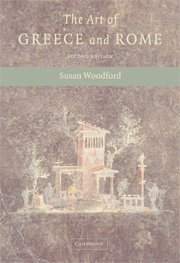Book contents
- Frontmatter
- Contents
- List of Illustrations
- Acknowledgements
- Maps
- Introduction
- PART I THE ARCHAIC AND CLASSICAL PERIODS: PROGRESS AND PROBLEMS
- PART II THE FOURTH CENTURY BC AND THE HELLENISTIC PERIOD: INNOVATION AND RENOVATION
- 4 Sculpture
- 5 Painting
- 6 Architecture and Planning
- PART III THE ROMAN WORLD: ADOPTION AND TRANSFORMATION OF THE GREEK LEGACY
- Epilogue
- Appendix: How We Know What We Think We Know
- Glossary
- Further reading
- Index
6 - Architecture and Planning
- Frontmatter
- Contents
- List of Illustrations
- Acknowledgements
- Maps
- Introduction
- PART I THE ARCHAIC AND CLASSICAL PERIODS: PROGRESS AND PROBLEMS
- PART II THE FOURTH CENTURY BC AND THE HELLENISTIC PERIOD: INNOVATION AND RENOVATION
- 4 Sculpture
- 5 Painting
- 6 Architecture and Planning
- PART III THE ROMAN WORLD: ADOPTION AND TRANSFORMATION OF THE GREEK LEGACY
- Epilogue
- Appendix: How We Know What We Think We Know
- Glossary
- Further reading
- Index
Summary
Several of the most important tendencies in the development of Hellenistic architecture can be grasped if we look at just three types of buildings: houses, theatres and sanctuaries.
THE HOUSE: NEW LUXURY IN PRIVATE LIFE
During the Hellenistic period, when people lived as part of huge kingdoms governed by remote rulers, they could no longer identify so immediately with their communities and began to feel isolated and alone. Their interest became focused on themselves at a time when emphasis, both emotional and economic, withdrew from the group and shifted on to the individual. People thought increasingly about their private lives and tried to make the intimate world around them more attractive and agreeable. They began to build more elaborate and comfortable houses for themselves; rulers, too, touched by the same sense of isolation, began to build palaces.
Fifth-century bc houses in Athens had been very modest (Fig. 87a). They usually consisted of two storeys and were built of unbaked brick on a low stone base. The entrance was somewhere along one side and led, sometimes rather indirectly, to a central courtyard. The courtyard was a simple affair, a source of light and air for the rooms that opened off it. A blank wall faced on the street, pierced only by small windows whose height above the street ensured privacy.
By the 4th century bc, such humble dwellings had, whenever possible, been improved upon.
- Type
- Chapter
- Information
- The Art of Greece and Rome , pp. 81 - 88Publisher: Cambridge University PressPrint publication year: 2004



